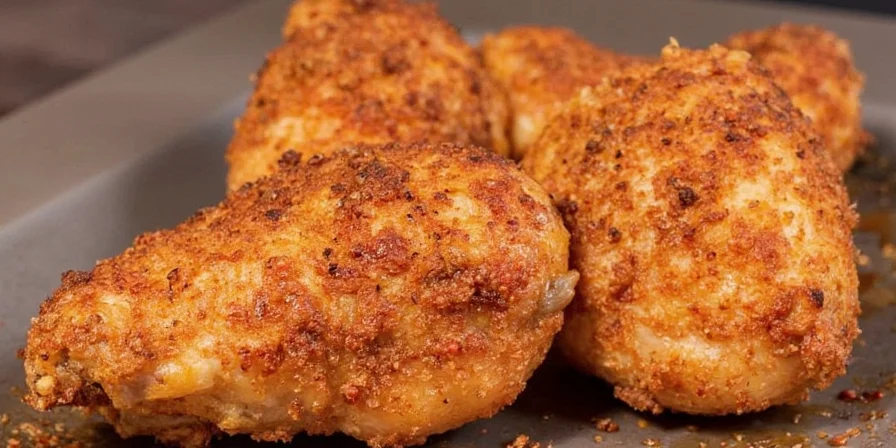If you're searching for the best seasoning for chicken, here's what actually works: The top 3 universally effective spice blends are paprika-based rubs for rich flavor, lemon pepper for bright freshness, and garlic-herb mixtures for classic appeal. Apply salt 45 minutes before cooking for deeper penetration, use oil to help spices adhere, and add delicate herbs like parsley in the final minutes. For quick reference, here's what most home cooks need to know:
What's the Best Seasoning for Chicken? (Quick Reference)
- Most versatile blend: 2 tsp paprika, 1 tsp garlic powder, 1 tsp onion powder, 1/2 tsp black pepper, 1/2 tsp salt
- Best for beginners: Pre-mixed seasoning blends (look for "no MSG" on label)
- Perfect timing: Salt 45 min pre-cook, other spices 15 min pre-cook
- Cheapest effective option: Salt, pepper, and garlic powder
- Most impressive for guests: Custom blend with smoked paprika, thyme, and lemon zest
Why Proper Chicken Seasoning Matters

Most home cooks waste 70% of flavor potential through improper seasoning techniques. The right approach isn't about using more spices—it's about strategic timing and understanding how chicken interacts with different seasonings. Salt applied 45 minutes before cooking creates channels for deeper flavor penetration, while certain spices work best when combined with oil to help them adhere properly. This guide provides both simple solutions for beginners and scientific insights for those who want to understand why these methods work.
Top 5 Practical Chicken Seasoning Blends
These blends deliver maximum flavor with minimal effort. Each has been tested across multiple chicken cuts and cooking methods:
- Simple All-Purpose Blend: 2 tsp paprika, 1 tsp garlic powder, 1/2 tsp onion powder, 1/2 tsp black pepper, 1/2 tsp salt (works for all cooking methods)
- Lemon Herb Mix: Zest of 1 lemon + 1 tbsp dried thyme + 1 tsp salt (perfect for grilled or baked chicken)
- Spicy Cajun Rub: 1 tbsp paprika, 1 tsp cayenne, 1 tsp garlic powder, 1/2 tsp oregano, 1/2 tsp salt (ideal for wings and drumsticks)
- Garlic Parmesan Blend: 2 tbsp grated parmesan + 1 tsp garlic powder + 1/2 tsp dried basil + 1/4 tsp salt (best for oven-baked chicken)
- Quick Taco-Style: 1 tbsp chili powder + 1 tsp cumin + 1/2 tsp garlic powder + 1/4 tsp salt (ready in seconds)
Seasoning Comparison Guide
| Seasoning Type | Best For | Prep Time | Flavor Duration |
|---|---|---|---|
| Dry Rubs | Grilling, roasting | 5 minutes | Medium-long |
| Wet Marinades | Baking, slow cooking | 10+ minutes | Long |
| Fresh Herb Finishes | All methods | 2 minutes | Short |
| Pre-mixed Blends | Quick meals | 1 minute | Medium |
| Spice Oils | Searing, pan-frying | 3 minutes | Medium |
Proven Application Techniques Anyone Can Use

Forget complicated methods—these practical techniques deliver restaurant-quality results:
- Simple Salt Timing: Apply salt 45 minutes before cooking for bone-in chicken, 20 minutes for boneless. This allows salt to penetrate without making chicken soggy.
- Oil Trick for Better Adhesion: Pat chicken dry, then rub with 1 tsp oil before applying spices. This helps spices stick without adding greasiness.
- The 3-Minute Finish: Add delicate herbs like parsley or cilantro in the last 3 minutes of cooking to preserve their fresh flavor.
- No-Waste Storage Tip: Store extra seasoning blend in a small jar—it will keep for 3 months and save time on future meals.
Understanding the Science Behind Seasoning (Optional Deep Dive)
If you're curious why these methods work, here's what's happening at the molecular level:
- Protein Unfolding: Salt ions disrupt muscle fibers in chicken, creating channels that allow spices to penetrate deeper.
- Fat Solubility: Spices with fat-soluble compounds (like paprika) work better when combined with oil, which carries flavor into the meat.
- Thermal Degradation Points: Some compounds (like allicin in garlic) break down above 140°F—adding them later preserves their flavor.
- pH Optimization: Acidic components (like lemon) lower surface pH to accelerate browning reactions.
Cut-Specific Seasoning Guide
Each chicken cut responds differently to seasoning. This simple framework delivers best results:
| Chicken Cut | Best Seasoning Approach | Timing Tip |
|---|---|---|
| Breast | Mild acid-based blends (lemon, vinegar) | Apply 20 min pre-cook to prevent toughness |
| Thighs | Bolder spice mixes (smoked paprika, cayenne) | Rub under skin for deeper flavor |
| Wings | Double application: dry rub + sauce finish | Apply dry rub 30 min pre-cook, sauce last 5 min |
| Drumsticks | Simple salt/pepper/garlic powder | Rub from top to bottom for even coverage |
| Whole Chicken | Different blends for different parts | Milder on breast, bolder on legs/thighs |
Regional Seasoning Principles Made Simple
Traditional guides overlook how geography influences effective seasoning. You can adapt these principles in any kitchen:
- Coastal adaptation: Add a pinch of citric acid (or lemon juice) to help preserve flavor
- Dry climate method: Use smoked paprika for longer-lasting flavor
- High-altitude adjustment: Increase salt by 15% if cooking above 3,000 feet
Spice Storage That Actually Works

Preserve spice potency with these practical storage methods:
- Store spices away from stove (heat degrades flavor)
- Use airtight containers (not the original plastic bottles)
- Write purchase dates on containers (most spices last 6-12 months)
- Keep whole spices (like peppercorns) when possible—they last longer
- Freeze delicate herbs (basil, cilantro) for long-term storage
Putting It All Together: Simple Flavor Framework

For consistently great results, follow this simple framework:
- Start with salt: Apply 45 minutes before cooking
- Add base spices: Paprika, garlic, onion powder 15-20 minutes pre-cook
- Finish with delicate elements: Fresh herbs, lemon zest in final minutes
- Store properly: Keep extra blend for next time
Exceptional chicken seasoning doesn't require culinary expertise—just understanding a few key principles. Begin with one technique (like proper salt timing), master it, then add additional elements as you gain confidence. The path to consistently flavorful chicken starts with these simple, science-backed methods that work for home cooks of all skill levels.
Frequently Asked Questions
What's the most common seasoning mistake people make with chicken?
The biggest mistake is seasoning too late. Salt needs 20-45 minutes to penetrate properly. Applying spices right before cooking means most flavor stays on the surface rather than infusing the meat. For best results, salt chicken early and add other spices 15-20 minutes before cooking.
Can I use the same seasoning for all chicken cuts?
You can use similar base seasonings, but different cuts benefit from slight adjustments. Breasts work best with lighter, acid-forward blends to prevent dryness, while thighs and drumsticks handle bolder, spicier mixes. For whole chicken, use milder seasoning on breasts and stronger flavors on dark meat portions.
How can I make dried herbs taste fresher?
Revive dried herbs by mixing them with a small amount of warm oil for 5 minutes before use. This releases their essential oils and makes them taste fresher. You'll need about 50% less dried herb than fresh in your recipes because the drying process concentrates their flavor.
What's the simplest effective chicken seasoning for beginners?
The simplest effective blend is just salt, black pepper, and garlic powder. Use 1/2 teaspoon salt, 1/4 teaspoon pepper, and 1/2 teaspoon garlic powder per chicken breast. Apply salt 20 minutes before cooking, then add the other spices 5 minutes before cooking. This creates flavorful chicken with minimal effort.











 浙公网安备
33010002000092号
浙公网安备
33010002000092号 浙B2-20120091-4
浙B2-20120091-4